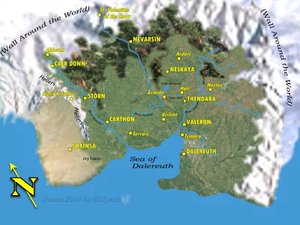Darkover
|
|
Darkover is the locus of the Darkover series of fantasy and science fiction novels and short stories by Marion Zimmer Bradley and others published since 1962. According to the novels, Darkover is only human-habitable of seven planets orbiting a fictional red giant star called Cottman.
| Contents |
The Cottman stellar system
Of the seven Cottman planets, Darkover is the fourth-farthest in orbit, which gives the planet its other name, Cottman IV. Two of the three planets (Cottman II and Cottman III) which are closer to the system's star are gas giants, the third (Cottman I) is a barren, scorched rock too close to its star to sustain life. Of the three outer planets, the two farthest from Cottman (Cottman VI and Cottman VII) are gas giants akin to Earth's Jupiter and Saturn. Cottman V is an ice planet that while not toxic to humans, cannot naturally support a self-sustaining human population.
Like its neighbor, Darkover, too is a planet stuck in a permanent ice age with only one small equatorial strip of its only, smallish continent warm enough to support limited agriculture, fishing and livestock. But the planet's climate is harsh by any standard, with the warmest parts of the world snow-free for only a few weeks out of the year.
Similar in size to Earth, Darkover has a lower gravity due to its relative lack of metals and a higher percentage of oxygen in the atmosphere. Its orbit is also slower than Earth, with one Darkover year roughly equal to 15 Earth months.
Darkovan Weather and Geography
Darkover's weather is affected by two major forces:
- A huge mountain range called "The Wall Around the World" which due to the lower gravity have grown to a height of 9,000 meters above sea level. This mountain range has the cooling effect of a third pole and has set the angle Darkover's axis of rotation to be more extreme than that of Earth's which causes an extreme fluctuation between summer and winter temperatures in its equatorial region.
- Unlike the Earth, which has only one natural satellite, Darkover has four moons which affect tidal forces and a weather patterns.
Darkover's four moons vary in size and color, two are appear large from the surface of the planet. The largest is named Liriel, and appears to have a violet tint. The second largest, Kyrrdis, is described as "peacock blue", of the four moons, the third, sea-green hued Irdriel appears to be mid-range in size while the fourth, Mormallor is a very small white moon. It is thought that Mormallor may be a passing asteroid that was captured by Darkover's gravity.

Viewing Darkover from space, the planet is dominated by polar icecaps that cover a majority of its surface. The sole continent, just a few degrees north of the equator, is linked to the northern icecap on the continental northern and eastern side where glaciers from The Wall Around the World mountain range abut the cap. To the south and west of that mountain range is Darkover's nominally temperate continental zone which borders open water of the planet's ocean.
This part of the continent is dominated by forests of giant evergreen trees that grow in the mountain foothills to heights unimaginable on Earth due to the planet's lower gravity. Further southwest from the forests are Darkover's highlands, plains, salt marshes and arable river valleys. On the planet's far western side are another mountain range called "The Hellers" and a high elevation cold desert plateau called "The Dry Towns."
Sentient native Darkover life
When humans first land on Darkover, they soon find an ancient world already inhabited by sentient life forms.
Catmen
Territorial cat-like non humans with primitive laran. Known to trade with Dry Towners and attack travellers.
Chieri
One of the first native species Earth explorers find are the chieri, a race of extremely long-lived, six fingered, tall and telepathic individuals of semi-hermaphrodite physiology. The chieri also are a race on the verge of extinction due to low fertility rates. But it is found in rare instances that chieri and human can interbreed.
Kyrii
Humanoid-type bipeds, kyrii are covered with grey fur and have monkey-like faces with glowing green eyes. Kyrii can give off electric shocks.
Trailmen
This semi-arboreal race of vegetarians build large cities in Darkovers tall trees. Their population suffers when humans live nearby.
Ya-men
Although the actual intelligence of this bird-like race is in question, these mountain-dwellers are seldom seen by humans who inhabit the low lands.
See Also
- Darkover series
- Darkover Map For Wikipedia's large detail map of Darkover
- Marion Zimmer Bradley
- List of Darkover books
External links
- Marion Zimmer Bradley Literary Works Trust (http://mzbworks.home.att.net/index.htm)
- Darkover Fan Convention (http://www.darkovercon.com/)de:Darkover

